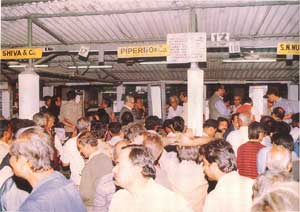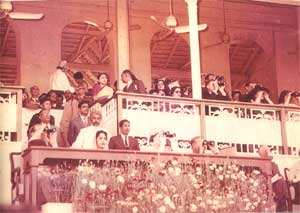The
pari-mutuel, the forerunner of the Tote, was introduced in 1872. And the first Monsoon
Meeting to take place in Calcutta was in 1879 when a course was constructed for the
purpose inside the flat course. By 1880 important changes had taken place. For example, it
was decided to race in the afternoons: the course was turned round and the new Stands were
built-the present imposing stands came later. It was that year, also, that saw the
beginning of the general public's growing interest in racing as a spectator sport.Lord Ulrich Browne was followed between 1886 and 1897 by Sir William
McPherson whose contributions to racing are incalculable. His achievements included the
complete upgrading of the Rules of Racing with new important rules added, establishing
close liasion with the Bombay Turf Authorities resulting in the signing of a reciprocal
agreement to adopt the rule that no course in India be allowed to race under Rules without
being controlled by either of the two Turf Authorities. Other measures introduced by Sir
William were the publication of the official Racing calendar, the separation of gymkhana
races from the Rules of Racing, the appointment of a whole-time paid Secretary of the
Club, preclusion of jockeys from betting and the appointment for the first time in India
of a professional handicapper.
By this time, the stature of Calcutta Turf Club had grown very high.
By 1889, its jurisdiction extended to all the courses in India excepting Bombay, Poona,
Karachi and Khelapur which raced under Bombay, and there were as many as 52 courses in
India (and Burma) at that time. The appointment in 1908 of a Stipendiary Steward for the
first time in India was also an innovation of the Calcutta Turf Club. The same year the
Maharaja Dhiraja Sri Bejoy Chand Mahtab of Burdwan became the first Indian to be elected
to the full membership of the club.
In due course his son, Sir Uday Chand Mahtab, was also extended full
membership amongst other important personalities such as Sir Biren Mukherjee and Mr.
Sachin Chowdhury (later, Finance Minister Govt. Of India).
Sir Uday Chand Mahtab who succeeded his father as Maharaja Dhiraja
of Burdwan joined the body of Stewards in the year 1947 and was elected as the Senior
Steward of RCTC in 1955 and continued to hold this eminent office for 27 years. During
this period the Club went from strength to strength. He helped the formation of the South
India Turf Club so that they could control racing in South India. Amongst his notable
achievements was the honor extended to him by the Jockey Club of England requesting him to
visit England, Hongkong and report back whether the standard racing and its administration
merited recognition by the Jockey Club itself. As the Maharaja's report appears to have
been favorable. It would seem that the Jockey Club thereafter extended its approval to the
Hongkong Jockey Club.
In the meantime, steeple chasing had become quite popular in
Calcutta in the 1870's. The C.T.C. brought it under its control in 1888, introducing the
first Grand National to be run at the main course in 1895. The last one was run in 1929;
it was won by a horse called Kilbuck who subsequently took part in the English Grand
National in 1931. He belonged to a steward of the Club who was incidentally the father of
the famous actress Vivien Leigh.
Before coming to some events of the recent past, one should not omit
to mention other noticeable dates in the history of the Club. The visit of the Prince of
Wales (later King George V) to the Calcutta Races in 1905, the building of the present
magnificent stands in 1905, and 1907, and the opening of the Stand Membership, as well as
the use of the first timing device on the Course in 1907.
One should also include in this list of outstanding events, the
construction of the existing Monsoon track undertaken by the club in 1910. This is a
unique track-perhaps the only one of its kind in the world-in that by some ingenious
device, it is the quickest draining track that one could imagine. At the same time, the
Randwick rails were fitted on the track. This type of rail is now universally used but at
that time in the early nineteen hundreds, it was an innovation.
Then came the granting of the appellation 'Royal' to the title of
the Club in 1912, following King George V's second visit to the Calcutta Races.
The extensive Stands of the Calcutta Race Course, white amidst lush
green open space, have a special charm. Away on the horizon are the high-rise city
buildings and nearer, the white marble grandeur of the Victoria Memorial in its well
planted park. This magnificent edifice stands sentinel as it did in the year when the
Calcutta Races were honored by the visit of Her Majesty Queen Elizabeth II on which
occasion, she presented her own trophy which she continues to donate every winter.
For her, it must have been a moment of special significance and not
a little nostalgia to have done so against the backdrop of the Memorial erected to honor
her great, great grandmother.
For the records, Sir Uday retired from the Stewardship of R.C.T.C.
in 1979. He was succeeded by Mr. B. M. Khaitan who joined as Steward in 1971. Mr. Khaitan
proved an outstanding administrator of sport and continued to maintain the Club's
reputation at the highest possible level. He is now the Patron of the Royal Calcutta Turf
Club. Mr. Khaitan was followed by Mr. O.A.V. Sen but sadly because of his death after
about one and half years, he was followed by Mr. Pran Prasad who on retirement handed over
the office to Mr. Pearson Surita, who in turn was followed by Mr. Sunil Singh Roy. The
current Senior Steward is Mr. B. M. Varma. Mr. B. M. Varma, a veteran polo playing
horseman and ex-president of Calcutta Polo Club who, inspite of innumerable increasing
problems involving Trade Union activities, cost maintenance, discipline and shortage of
funds, maintains the excellent reputation of the country's premier racing centre. Calcutta
at one time exercised racing control and rules of racing over 73 racing centers in the
sub-continent extending between Peshawar and Mandalay.


